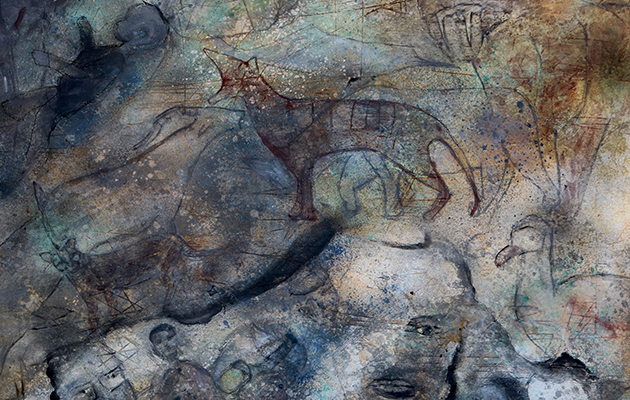Katrina Slack’s work does more than simply depict environmental concerns – it incorporates them, as she explains to Janet Menzies
As we begin to tackle the enormous damage inflicted on sealife by our excessive use of plastic, Katrina Slack is turning that very refuse into beautiful, and upsetting, art, as she tells Janet Menzies.
For more sporting artists, Susan Leyland has created a sculpture to remember the equines that fell during World War I. And Archibald Thorburn’s paintings are unique from the Golden Era of fieldsports.
KATRINA SLACK
Summer is here and it’s time to head down to Cornwall and then to the beach. Roll up your trousers and go paddling; enjoy the little sea creatures nibbling at your toes. While you’re doing that, think about Art, because those nudges and tickles against your feet are more likely to be chunks of discarded plastic waste than charming crabs or shrimps. And that’s where St Ives-based artist Katrina Slack comes in, making beautiful sea-life sculptures from the very refuse that is threatening the animals’ lives.

In 2014, Katrina Slack was commissioned by the World Animal Protection to make sculptures from “ghost gear”, including this Whale.
The shores of Cornwall have always been inspirational, especially to the creative communities at St Ives and Newlyn. Artists such as Walter Langley and Stanhope Forbes were drawn not just by the light and natural scenery but also the colourful lives and environments of the fishermen and their families. These weren’t always depicted sentimentally, there was no shying away from the dangers and sometimes tragedies associated with working the sea. Today, it is the humans inflicting damage on the sea and Slack’s work is both beautiful and upsetting.
“My large sculptures of sea creatures are all made out of ghost fishing line,” she explains. “My first piece was a dolphin, which I had on display down here, made from fishing-line refuse I find on the beach. By coincidence, someone from World Animal Protection was staying and saw the dolphin. As a result, I was commissioned to make several more sea-life sculptures to publicise the organisation’s Sea Change campaign. I think my leatherback turtle has become quite high profile now. It was used outside the Houses of Parliament to raise awareness and then went to the Natural History Museum and is now going on to Los Angeles.”

Slack’s first piece was a dolphin, made from fishing line refuse found on the beach.
Slack’s turtle made from ghost fishing gear looks frighteningly like real photographs of turtles on the Sea Change website, showing the animals enmeshed in shrouds of highly coloured plastic fishing line. It took the Blue Planet documentaries to engage the general public with the devastating consequences of plastic waste at sea but Slack’s work has been campaigning ever since she came to St Ives. “Living down here you can’t help but be aware of the state of the seas. But the real problem is invisible to most of us because the plastic gets caught up in the centre swells out in the ocean, even though so much is also washed up on the beach. I don’t mind a bit if people are jumping on the bandwagon of an issue that I have been raising in my art for a long time – it’s a good bandwagon to be on. It was fantastic to see the way the documentaries raised awareness.”
RESPONDING TO THE ENVIRONMENT
Slack started out as a photojournalist and even played in a band for a while before diverting into art. She says: “I found myself in St Ives and everybody who lives in St Ives is a painter, so…” But Slack’s journalistic awareness quickly led her away from the traditional Cornish seascape, although she still paints these. “My work responds to my environment just as every artist’s does, but perhaps the expression is different. For example, there was a spillage from a cargo ship and hundreds of orange plastic spoons were washed up on the beach, so I made a big sun picture from them. Whenever I come across something, I think, ‘Oh, I could make something out of that.’ I’m a hoarder of things for the same reason – I may see something in them one day.”
Even with her collecting tendencies, making one of her ghost-gear sculptures is demanding for Slack, requiring intensive beachcombing to gather all the fishing line. “I also use copper wire that comes out of old washing machines,” she adds. Another project, making smaller sculptures of birds and land animals out of disused chicken wire, came to hand more easily. “It was just loads of old stuff the previous owners of my house left in the garden when they moved.”

One of Slack’s “cave paintings”.
It’s as though those litterbug owners had walked away from a treasure trove. Slack found material sculptures have an extraordinary, jewel-like quality. Her turquoise seahorses have exactly the fragile delicacy of the living animals, while her kingfisher’s wire and plastic plumage is every bit as electric blue as the real bird.
Recently, Slack has begun working on her own version of cave paintings, depicting extinct animals as though on a cave wall. “The art of prehistoric people was the first thing that defined us as humans. I love the way those early painters captured the animals so sympathetically and got them so correct. Those cave paintings show their love of the animals and the environment surrounding them.”
Prehistoric man fished and managed to hunt and feed himself without compromising his natural larder – a skill that we have since lost.
Check out www.katrinaslack.co.uk to find out where to see Slack’s work and for news of her latest projects. To find out more about the Sea Change campaign, visit
www.worldanimalprotection.org or www.seachangeproject.com





